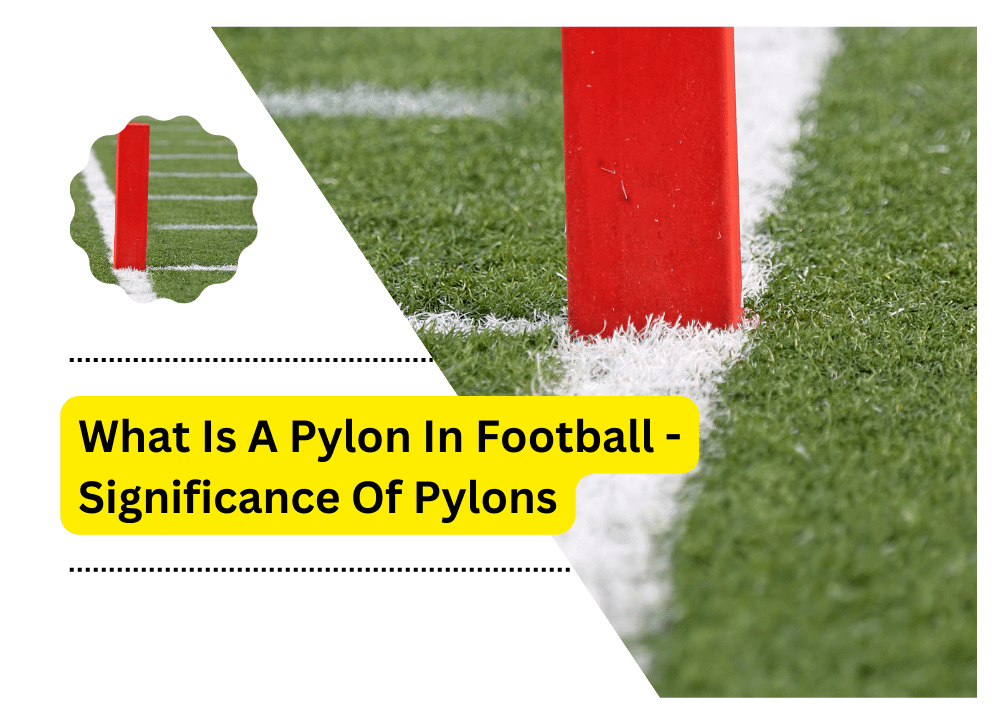What Is A Pylon In Football – Significance Of Pylons

Pylons are the orange markers that state the field’s boundaries in American football. They define how far downfield a player can go before referees consider them out-of-bounds. They also help referees determine when a play has passed the line of scrimmage.
Since the beginning of professional football, teams have used pylons. Their design has changed over the years. This article will explore what is a Pylon in Football and the significance of pylons in American football.
Definition of a Pylon
A pylon is a 4-foot tall, orange marker that indicates the boundary lines on an American football field. Teams place them at either side of the goal line and each corner of the end zone. Both professional and amateur stadiums feature pylons. Referees rely on them to determine when a player has gone out of bounds.
Significance of Pylons in Football
Pylons are important for football as they help to keep the game fair. Without pylons, it would be difficult for referees and players alike to determine where exactly the field’s boundaries are. They also ensure that players stay within their designated positions. It helps prevent them from straying out-of-bounds or beyond the line of scrimmage.
Besides this, pylons mark the end zone. It is particularly relevant for quarterbacks who need to know exactly when they have thrown a touchdown pass.
Purpose of Pylons
Here we will discuss What is a Pylon in Football Pylons serve several crucial purposes in a game of football.
Marking the Boundary
The most straightforward purpose of pylons is to mark the boundaries of the field. It includes the goal line and each corner of the end zone. Pylons provide players, referees, and spectators with a visual guide. It helps them understand the playing area’s layout.
Guiding Players
Pylons are vital tools for players. It is especially true for the quarterback. They help them understand their positioning on the field. They state the end zone, a critical area for scoring points through touchdowns.
Assisting Referees
The most significant purpose of pylons is to aid referees in making calls. They help determine when a player has gone out of bounds, or a ball has crossed the line of scrimmage.
Enhancing Gameplay Fairness
By marking the field’s boundaries, pylons contribute to maintaining fairness in the game. They prevent players from straying out-of-bounds or beyond the line of scrimmage.
Indicating Touchdowns
Finally, the role of pylons is critical in indicating touchdowns. If a player in possession of the ball touches a pylon, it is considered a touchdown, adding to the excitement of the game.
Impact of Pylons on the Game
Role in Game Fairness
Pylons play an integral role in maintaining fairness in football games. Their conspicuous presence on the boundary lines ensures that players and referees can immediately identify when a player steps out of bounds.
Importance in Scoring
For scoring, pylons are crucial. Quarterbacks and other players need to be aware of the precise location of the end zone to score touchdowns. Pylons simplify this process by providing a clear visual marker that distinguishes the end zone from the rest of the field.
Evolution of Pylon Design
Over the years, the pylon’s design has undergone significant changes. We aimed to improve visibility and durability with these changes. Manufacturers create modern pylons from flexible materials to prevent injuries. They equip these pylons with cameras to aid referees in making close calls.
Pylons in Professional vs Amateur Leagues
While pylons are a staple in professional leagues, their use in amateur leagues varies. Despite this, their role in ensuring a fair game and accurate scoring remains constant across all levels of play.
Types of Pylons
Traditional Pylons
Traditional pylons often seen in amateur leagues, are simple, four-sided cones of bright orange vinyl. Their design makes them visible, lightweight, and movable.
Professional Pylons
In professional leagues, advanced features equip pylons. These include built-in cameras to ensure accurate calls for scores and out-of-bounds plays. They’re also made from flexible materials to ensure player safety.
Weighted Pylons
Designers create weighted pylons to return to an upright position even after someone knocks them over. This design feature ensures the consistent visibility of field boundaries. People use these in windy conditions or on uneven playing fields.
Custom Pylons
Custom pylons are often seen in high-profile matches or championships. They may bear the event’s logo or sponsoring company in such cases. These pylons serve both a functional and promotional role during games.
FAQs
A: Yes, pylons are important for football. They mark the field’s boundaries and help referees make close calls. They also assist players in understanding their positions on the field and state touchdown passes.
A: Manufacturers make traditional pylons from bright orange vinyl. They construct professional pylons from flexible materials to ensure safety. People can make weighted pylons from rubber or plastic. They can fashion custom pylons from various materials.
A: Yes, there are several types of pylons. Amateur leagues use traditional pylons, which are simple four-sided cones. Professional pylons have built-in cameras and flexible materials to ensure player safety. Weighted pylons return to an upright position even after someone knocks them over.
A: The main purpose of pylons in football is to mark the field’s boundaries and guide players. Additionally, they assist referees in making calls. They are also used for scoring purposes. They show when a player has achieved a touchdown.
A: Many leagues must inspect and replace pylons when worn out or damaged. It is especially true for professional leagues. Proper game equipment is essential for ensuring player safety. Experts recommend inspecting pylons at least twice a year.
Conclusion
What is a Pylon in Football – Pylons are an integral part of football, ensuring fairness and accuracy in the game. Players would experience confusion about the exact boundaries of the field without them. Referees would have difficulty determining out-of-bounds plays and scoring touchdowns. Pylons come in various forms to accommodate different playing conditions. These range from traditional four-sided cones to weighted, camera-equipped models.






